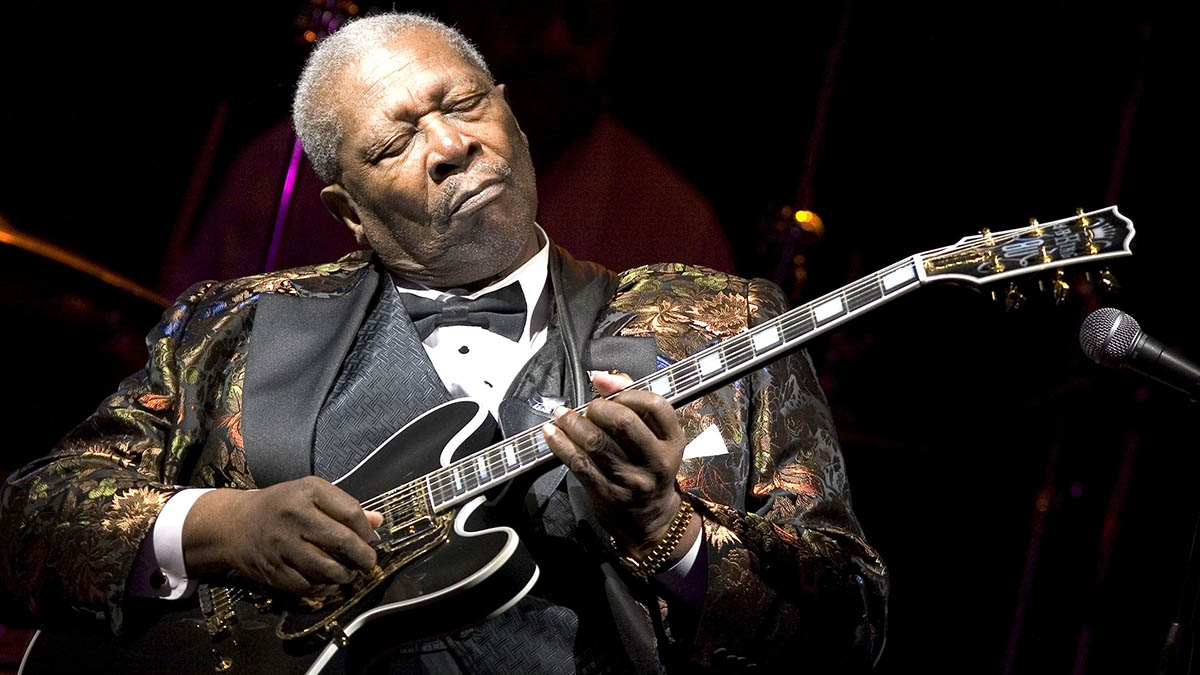
In this month’s column, I’m showing you another set of licks from my book, 100 Essential Blues Guitar Intros. This month’s subject is blues legend B.B. King. King made every note count using his powerful vibrato trill to wring as much emotion from his playing as possible. Using space in his soloing made him highly melodic, and many of his intro licks are like perfectly composed solos within themselves.
King’s taste and restraint meant he spent as long he saw fit on an intro phrase. One of his biggest mainstream hits, The Thrill Is Gone is the perfect example of this, as B.B. plays a melodic melodic intro solo all the way through the progression before the vocals come in.
Lesser blues players would have jumped straight into the song, but King always understood the importance of setting the scene, so let’s explore his mastery of creating tension and release in his intros before getting into actual songs.
Get the tone
Amp Settings: Gain 3, Bass 7, Middle 6, Treble 7, Reverb 2
KIng was known for his use of a Gibson ES-355 electric guitar and Gibson Lab Series amp to create his warm, jazzy tone. But any guitar will work great here if you select the neck pickup, use a ‘just breaking up’ amp tone (or a smooth but light overdrive from a pedal), and add enough reverb to add a pleasant ambient wash to the tone.
Example 1
Our first example shows how you can get a simple Minor Pentatonic scale idea, in this case B Minor Pentatonic (B-D-E-F#-A), doing all the work for you, as long as you include, as B.B. always did, great phrasing and a sense of space.
Example 2
This example contains a great B.B. lesson - that you don’t always have to start on beat 1. Again it’s all about phrasing within the B Minor Pentatonic scale here, and using tasty bends such as the one in Bar 1 at beat 3. Also notice the blues curl (quarter tone bend) on the D notes, adding attitude to the Bm chord.
Example 3
This lick is an example of how using space can contrast with more rapid-fire ‘jumpy’ licks. Playing in a different register and position can get you thinking about new ideas, and sometimes restricting yourself to playing on just two strings can help you think more creatively.
Example 4
With this one, spend time creating quality quarter-tone bends (blues curls) without overbending, as this would allude to a B Major sound which you don’t want. B.B. frequently referenced the root note (in fact he usually pivoted off it), so this phrase keeps coming back to the note B to match the underlying B Minor chord.
Example 5
The final lick of this first set in B Minor ties together many of the ideas you have studied in the preceeding phrases. There are varying degrees of string bending, bend and release, plus more of that wide and fast vibrato that’s at the heart of the B.B. King style.
Example 6
Moving to C Major, this lick starts off with the classic Minor to Major 3rd hammer-on move (Eb-E) followed by a challenging rhythmic phrase where four notes are played evenly on beat 4 against the underlying triplet feel. The blues masters would play these rhythms without thinking even about it!
Example 7
This lick combines C Minor and Major Pentatonic (C-Eb-F-Ab-Bb and C-D-E-G-A) phrases with plenty of string bending and a bend and release in the final bar.
Example 8
Deciding where to start your intro phrases is something to always keep working on – broadly speaking you can start low, mid-register, or higher up the neck. Having a good knowledge of scales and positions is crucial and opens up options to play in different registers .
Example 9
We go beyond Pentatonic scales in bar 3 with the C Blues scale (C-Eb-F-Gb-G-Bb) over the F7 chord. A great tip is to use the I chord’s blues scale over the IV chord for a really different sound. B.B. often used jazzier approaches like this when the mood took him.
Example 10
This intro starts off with an ascending C Major Pentatonic phrase in bar 1 followed by a descending C Minor Pentatonic line in bar 2. This creates contrast and movement and an intro like this can start to set the tone for the whole song.







